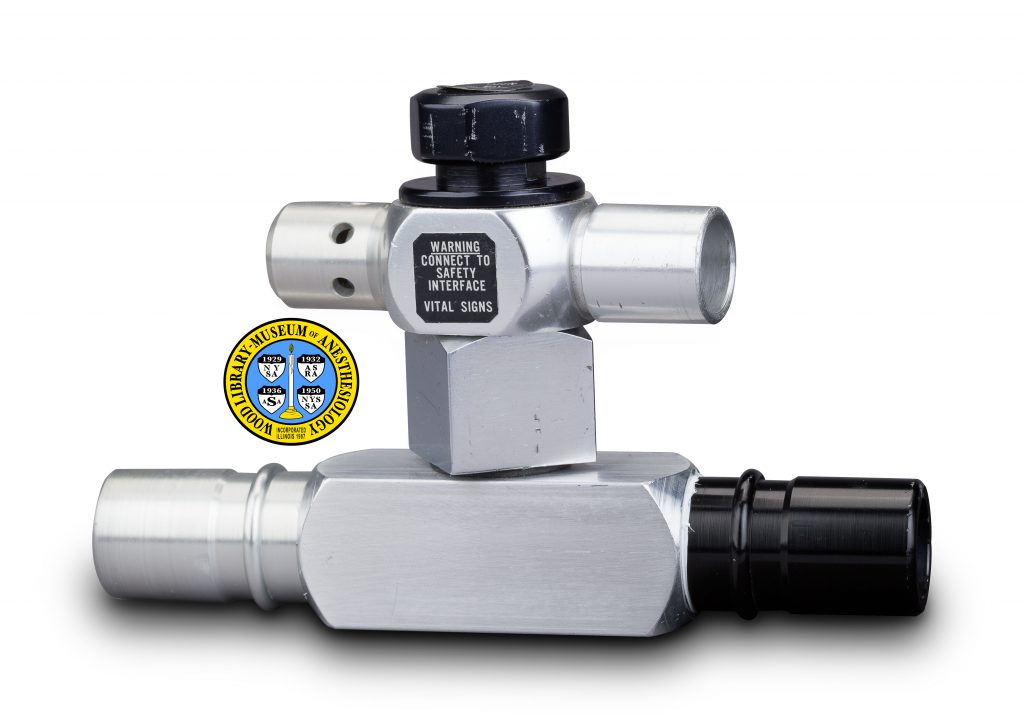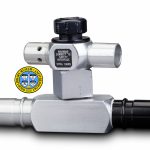Vital Signs Posivac Valve
Vital Signs Pop-off Valve (Adult)
British physicist William W. Mapleson PhD, DSc, FRCA (Hon.) (born 1926), analyzed five breathing circuits in 1954; these became known as Mapleson Systems. He concluded that the configuration now called "Mapleson D" was the best way to eliminate the patient's rebreathing of carbon dioxide. It consists of a tube with a mask at one end, an expiratory valve and a reservoir bag at the opposite end, and a second, smaller tube attached close to the mask. The smaller tube carries the fresh gas supply from the anesthesia machine. The larger tube carries the patient's exhaled breath to the reservoir bag. When the bag is full, it is vented out through the valve at some distance from the mask.
In the United States, a growing awareness of the possible health risks to hospital personnel from daily, repeated exposure to anesthetics led to the National Institute for Occupational Safety and Health to recommend measures that would limit such exposure. Published in 1977, this brought a surge of new gas scavenging equipment to the marketplace. Built into the breathing circuit of an anesthesia machine, a gas scavenger collects most of the waste gases for later disposal. Vital Signs, Inc., a medical equipment manufacturer based in New Jersey, marketed its Gasovac Scavenging System in the 1970s and 1980s. One component of the Gasovac was the Posivac pop-off, or pressure relief valve, shown here, which was made for use in a Mapleson D system.
Catalog Record: Vital Signs Posivac Valve Vital Signs Pop-off Valve (large)
Access Key: apoe
Accession No.: 2016-03-28-1 B
Title: [Posivac Pop-off Valve / Vital Signs].
Corporate Author: Vital Signs, Inc.
Title variation: Alt Title
Title: Mapleson-D pop-off valve.
Title variation: Alt Title
Title: Vital Signs Gasovac pop-off valve
Title variation: Alt Title
Title: Vital Signs pressure relief valve.
Title variation: Alt Title
Title: Vital Signs pop-off valve.
Publisher: [place of publication not identified] : Vital Signs, [between 1977 and 2000].
Physical Description: 1 valve : metals (aluminum?), plastics ;
Subject: Pressure Relief Valves.
Subject: Anesthesia, Inhalation – instrumentation.
Subject: Pressure – instrumentation.
Subject: Air Pollution, Indoor – prevention & control.
Note Type: General
Notes: The only pertinent manufacturer’s publications found by the cataloger are dated from 1978 to 1980. The first year in the date range is based on the year that the National Institute for Occupational Safety and Health published its first recommendations for limiting exposure to anesthetics. The second year in the date range is based on the donor’s statement that he used it in the 1980s and 1990s. During the time span of the date range, the manufacturer had premises in Little Ferry, New Jersey, then East Rutherford, New Jersey, followed by Totowa, New Jersey.
Described with the label facing the viewer. In this orientation the black, plastic connector is on the left.
Note Type: With
Notes: The object is attached to the adapter that would be used to connect the valve to the manufacturer’s Safety Interface. At one end, the adapter connects to a breathing bag. At the other end it connects to a hose leading to a mask. The adapter is configured for use in a “Mapleson D” breathing system.
Note Type: Citation
Notes: Azar I. Anesthetic gas spillage and scavenging. International Anesthesiology Clinics. Winter, 1981;19(4):1-37.
Note Type: Citation
Notes: Dorsch JA, Dorsch SE Understanding Anesthesia Equipment: Construction, Care and Complications. Baltimore: Williams & Wilkins, 1975:159-173.
Note Type: Citation
Notes: Dorsch JA, Dorsch SE. Understanding Anesthesia Equipment, 2nd ed. Baltimore: Williams & Wilkins, 1984:254-257.
Note Type: Citation
Notes: Geraci CL. Operating room pollution: governmental perspectives and guidelines. Anesth Analg. November-December, 1977;56(6):775-777.
Note Type: Citation
Notes: Maltby JR, ed. Notable Names in Anaesthesia. London : Royal Society of Medicine Press, 2002:132-134.
Note Type: Citation
Notes: Mapleson WW. The elimination of rebreathing in various semi-closed anaesthetic systems. Br J Anaesth. September, 1954;26(5):323-332.
Note Type: Citation
Notes: Mushin WW, Mapleson WW. Pressure-flowrate characteristics of expiratory valves. Br J Anaesth. January, 1954;26(1):3-10.
Note Type: Citation
Notes: Mushin WW, Rendell-Baker L, Thompson PW, Mapleson WW. Automatic Ventilation of the Lungs. 2nd ed. Oxford: Blackwell Scientific Publications, 1969.
Note Type: Citation
Notes: William Woolf Mushin [Obituary]. Independent website. http://www.independent.co.uk/news/people/obituary-professor-w-w-mushin-1480858.html. Accessed April 20, 2017.
Note Type: Citation
Notes: Milliken, RA, Wall TD, Boelens M, inventors; Vital Signs, Inc., assignee. Safety interface and valve for anesthesia scavenging. US patent 4,180,066. December 25, 1979.
Note Type: Citation
Notes: National Institute for Occupational Safety and Health. Occupational exposure to waste anesthetic gases and vapors: criteria for a recommended standard. Cincinnati, Ohio : U.S. Department of Health, Education, and Welfare, Public Health Service, Center for Disease Control, National Institute for Occupational Safety and Health, Robert A. Taft Laboratories, March, 1977.
Note Type: Citation
Notes: OSHA Directorate of Technical Support and Emergency Management. Anesthetic gases: guidelines for workplace exposures. Occupational Safety & Health Administration website. https://www.osha.gov/dts/osta/anestheticgases/#A. Published July 20, 1999. Revised May 18, 2000. Accessed April 7, 2017.
Note Type: Citation
Notes: University of Wales College of Medicine website. http://blogs.cardiff.ac.uk/bmccu/2015/03/16/the-bill-mapleson-centre/. Accessed April 20, 2017.
Note Type: Citation
Notes: Vital Signs company file. Archives. Located at: Wood Library-Museum of Anesthesiology, Schaumburg, Illinois.
Note Type: Physical Description
Notes: One scavenging pop-off valve; At the base of the valve is a square piece that connects to an adapter; With the valve turned at a right angle to the adaptor, the depth is approximately 7.5 centimeters; The valve turns 360 degrees on its base, making width and depth interchangeable; All but the interior disc is made of metal (aluminum?): At the top of the valve is an anodized aluminum disc (black in color) that holds the control knob; The control knob is also made of anodized aluminum, and turns 360 degrees on its base; The body of the valve has two extensions; The extension on the front of the valve consists of an open-ended connector that would lead to a part called by the manufacturer the Safety Interface (all these parts being components); On the back of the valve, opposite to this connector is a pressure relief valve, which holds a spring-loaded plastic disc; This extension is closed with a removable threaded cap; The right side of the body of the valve is labeled: “WARNING [new line] CONNECTS TO [new line] SAFETY [new line] INTERFACE [new line] VITAL SIGNS”; The top of the knob is labeled: “OPEN [new line] MAX [new line] PRESSURE [new line] 60 [new line] cm H2O”.
Note Type: Reproduction
Notes: Photographed by Mr. Steve Donisch, November 15, 2016.
Note Type: Acquisition
Notes: Gift of Quentin A. Fisher, MD, FAAP.
Note Type: Historical
Notes: In 1952, physicist William Wellesley Mapleson, PhD, DSc, FRCA (Hon.) (born 1926), applied for a job at the University of Wales College of Medicine (now the Cardiff University School of Medicine.) He was hired by William Woolf Mushin, FRCS, CBE (1910-1993), founder and head of the Department of Anaesthetics. His association with the University continues to the present day. One of Dr. Mapleson’s first assignments was to find a way to eliminate the patient’s rebreathing of his own exhaled carbon dioxide. To do so, Dr. Mapleson studied the five breathing circuits that had been identified by Sir Ivan Whiteside Magill (1888-1986).
Magill’s circuits consisted of five different configurations of equipment. All of the circuits included an anesthesia mask, one or more hoses, and an expiratory valve; four of the five circuits also featured a rebreathing bag. Mapleson called Magill’s five circuits “Systems” A through E, and published his analysis of them in September, 1954. This work received widespread attention, and the systems he described quickly became known as “Mapleson A” through “Mapleson E”. All of these circuits are non-rebreathing systems. In these systems, the exhaled and excess gases are not cycled through a carbon dioxide absorber, but are vented into the air of the operating room.
Dr. Mapleson concluded that System D came closest to the elimination of rebreathing. The configuration now called “Mapleson D” consists of a corrugated tube with a mask at one end, an expiratory valve and a reservoir bag at the opposite end, and a second, smaller tube attached close to the mask; this second tube carries the fresh gas supply from the anesthesia machine. The larger tube carries the patient’s exhaled breath to the reservoir bag. When the bag is full, it is vented out through the valve at some distance from the mask.
Together with his mentor Dr. Mushin, Dr. Mapleson was one of the coauthors of the textbook Automatic Ventilation of the Lungs, which was published in three editions. Among many other honors, he was awarded the 22nd triannual Hickman Medal by the Royal Society of Medicine in 1999.
A growing awareness of the possible health risks to hospital personnel from daily, repeated exposure to inhaled anesthetics led the National Institute for Occupational Safety and Health (now the Occupational Safety and Health Administration) to recommend measures that would limit such exposure. These recommendations were first published in 1977, and established Recommended Exposure Limits (RELs) for the exposure of hospital personnel to both nitrous oxide and halogenated anesthetics. This brought a surge of new gas scavenging equipment to the marketplace. Built into the breathing circuit of an anesthesia machine, a gas scavenger collects most of the waste gases for later disposal.
Vital Signs, Inc., a medical equipment manufacturer based in New Jersey, marketed its Gasovac Scavenging System in the 1970s and 1980s. One component of the Gasovac was the cataloged object, a Posivac pressure relief valve, also called a pop-off valve. It could be connected directly to a carbon dioxide absorber, or to a Mapleson D system. The Posivac model 630 was intended for use with anesthesia machines made by the Foregger Company. The Model 631 was intended for use with anesthesia machines made by the Ohio Company. The model of the cataloged object cannot be determined from the available information.
Note Type: Exhibition
Notes: Selected for the WLM website.


